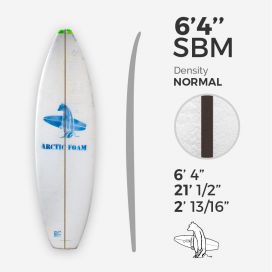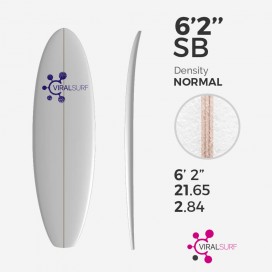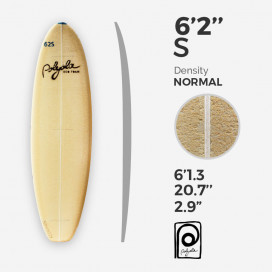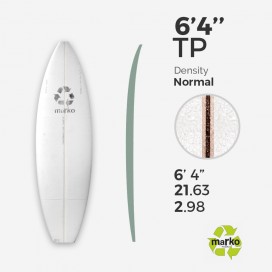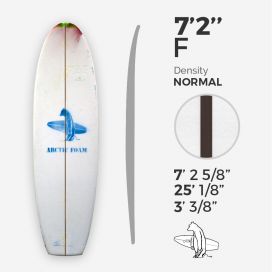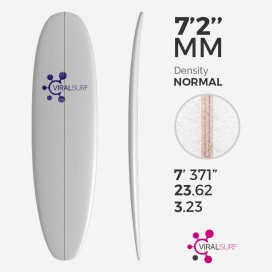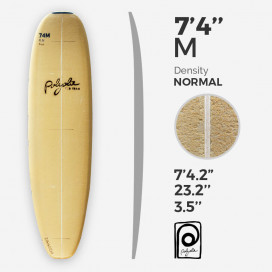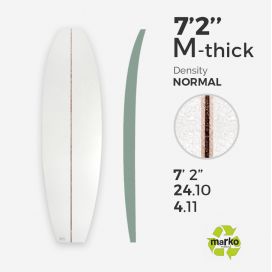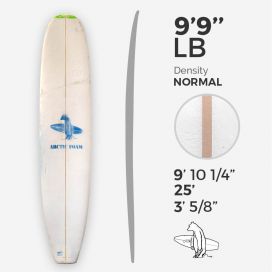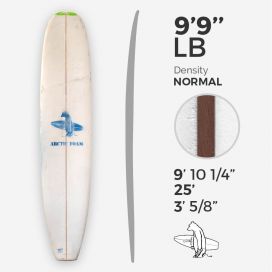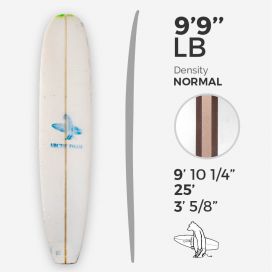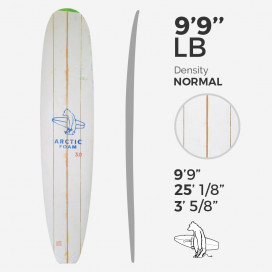
Before settling in the shaping workshop, it is advisable to understand all the diversity of boards that exists to know which board to make. They can be grouped into large families, taking into account their size, shape or general volume. The seven families identified here are not exhaustive but allow us to classify around common elements the vast majority of the boards that we are likely to shape. Here is an overview of their features and characteristics to make the right choice.
- Size | 5'8 — 7'6
- Width | 20"1/4 — 24"
- Thickness | 2"5/8 — 3"3/8
SHORTBOARD
The “short board” has been king of the line-up since the shortboard revolution of the late sixties, when boards under 7 feet replaced the 9-foot+ ones in the line-up. Designed for radical surfing based on maneuvers more than sliding, these boards need to be surfed in the hollowest parts of the wave to function. In exchange, the reduced dimensions allow short turns and on the rail, as well as passages in the tube. These boards are characterized by a pointed nose, little width, thin rails, rocker and 3 or 4 fins.

SHORTBOARD EQUIVALENTS IN OUR CATALOG
-
Polyurethane ARCTC Foam 6'4" x 21 1/2" x 2 3/16"; SBM Shortboard - Blank for shortbord shaping - 1/8" Black/Black/Black Ply stringer Typically used for shortboard or modern fishes shapes.
Dimensions | 6'4" x 21 1/2" x 2 3/16"
Stringer | 1/8" Black/Black/Black Ply
Density | Normmal (Green density)
Volume | 42,18 L
111,30 €
In Stock
-
Polyurethane VIRAL 6'2'' SB Shortboard - Blank for shortboard shaping - 4,5mm TB (ply) 3 x 1,5mm stringer
Dimensions | 6'2" x 21,65" x 2,84"
Stringer | 4,5 mm TB (ply)
Volume | 45,9 L
78,00 €
Out of stock
-
Polyoal developed a new, more sustainable, high – quality polyurethane foam core for surfboards (blank) that can be 100 % recycled, which we take responsibility for.
112,80 €
In Stock
-
EPS 6'4 TP - Marko Foam surfboard blank
Size | 6'4" x 21,63" x 2,98"
Stringer | 1/8" Plywood Natural / Black / Natural
Density | 1,9 - 30,44 kg/m3
112,30 €
In Stock
- Size | 5'10 — 7'2
- Width | 22" — 25"1/8
- Thickness | 2"13/16 — 3"5/8
FISH
A short, wide board that helps you gain speed (and maintain it) in small waves. Originally, the name referred only to twin-fins inspired by kneeboarder Steve Lis, with little rocker and a deep swallow tail. The design gained popularity in the 70s when Mark Richards was inspired by it for his famous twin-fins. Since the 90s, we talk about modern fish for any short and wide board dedicated to small surf.
- Size | 7'2 — 8'8
- Width | 21"5/8 — 25"1/2
- Thickness | 3"1/4 — 4"1/8
HYBRID
Originally a board mixing elements of shortboard and longboard, therefore an intermediate size board (7 or 8 feet) and quite round (see scalable below). We now find under this name shorter boards, hybrids between the shortboard and the fish. These are boards a little thicker than a shortboard, wider (especially at the front), with a fairly flat rocker for easier paddling, but which will keep modern rails and concaves to remain efficient.
- Size | 6'9 — 8'8
- Width | 21"5/8 — 25"1/8
- Thickness | 3"1/4 — 4"1/8
ÉVOLUTIVE
Another catch-all name for boards that allow you to catch waves easily, while remaining relatively compact. Often representing a step between the beginner longboard and the shortboard, they generally adopt a width greater than 20 inches to offer stability but a length less than 8 feet so that it can still turn. We also talk about funboard or mini-malibu. The egg is a model that we will not put in the same basket because it differs from other funboards by its thinness. This design, which appeared in the 70s, is intended to be a little more efficient.

EVOLUTIVE EQUIVALENCES IN OUR CATALOG
-
Polyurethane ARCTIC Foam 7'2 5/8" x 25" 1/8 x 3 3/8" FISH Blank for fish or egg shaping- 3/16'' Dyed Basswood Brown stringer.
Dimensions | 7'2 5/8" x 25" 1/8 x 3 3/8"
Stringer | 3/16" Dyed Basswood Brown
Density | Normal (Green Density)
Volume | 74,06 L
149,90 €
Out of stock
-
Polyurethane VIRAL 7'2'' MAL - Blank for mini mal shaping - 4,5mm TB (ply) 3 x 1,5mm stringer
Dimensions | 7'3,71" x 23,62" x 3,23"
Stringer | 4,5 mm TB (ply)
Volume | 69,2 L
104,40 €
Out of stock
-
Polyoal developed a new, more sustainable, high – quality polyurethane foam core for surfboards (blank) that can be 100 % recycled, which we take responsibility for.
Transforming the linear process of ‘take-make-waste’ towards a circular economy approach.
148,80 €
Out of stock
-
- Size | 9'3 — 10'9
- Width | 24"5/8 — 25"5/8
- Thickness | 3"3/8 — 4"1/8
LONGBOARD
Long boards, often more than 9 feet, but also very wide to maximize glide. A round nose allows you to walk to the end of the board to place 5 or 10 toes (hang five, hang ten). They are the direct heirs of the 60's boards (classic single fin longboard) or now boards open to a wider repertoire (modern longboard). With their ideal design for small waves and their rock-solid stability, they are also excellent learning boards.
- Size | 7'3 — 10'5
- Width | 22"1/2 — 23"7/8
- Thickness | 3"1/4 — 4"3/16
GUN
A long board that we wouldn't think of calling a longboard, because we're talking about a weapon entirely dedicated to surfing big waves. Its length allows you to paddle fast enough to catch big waves, which move faster. The pointed nose and the marked rocker make it possible to manage the drop, the narrow pintail to hold in an often vertical wall. The “real” gun measures 8 to 12 feet, below that we speak more of a semi-gun, and before that of stepup, a board just a little longer than your usual shortboard.
9'9 LONGBOARDS AND 3 STRINGERS
-
Polyurethane ARCTC Foam 9'10 1/4 x 25" x 3" 5/8 LB - Blank for longboard shaping- 3/8" Basswood stringer.
Dimensions | 9'10 1/4 x 25" x 3" 5/8
Stringer | 3/8" Basswood
Density | Normal (Green Density)
Volume | 108,13 L
206,00 €
In Stock
-
Polyurethane ARCTC Foam 9'10 1/4 x 25" x 3" 5/8 LB - Blank for longboard shaping- 3/8" Red Cedar stringer.
Dimensions | 9'10 1/4 x 25" x 3" 5/8
Stringer | 3/8" Red Cedar
Density | Normal (Green Density)
Volume | 108,13 L
237,30 €
In Stock
-
Polyurethane ARCTC Foam 9'10 1/4 x 25" x 3" 5/8 LB - Blank for longboard shaping- T-band 3/8'' Bass + 2 x 1/8" red cedar stringer.
Dimensions | 9'10 1/4 x 25" x 3" 5/8
Stringer | T-band 3/8'' Bass + 2 x 1/8" red cedar
Density | Normal (Green Density)
Volume | 108,13 L
266,60 €
In Stock
-
Polyurethane ARCTC Foam 9'10 1/4 x 25" x 3" 5/8 LB - Blank for longboard shaping- 3 stringers Red Cedar.
Dimensions | 9'10 1/4 x 25" x 3" 5/8
Stringer | 3 stringers Red Cedar— 6" between stringers
Density | Normal (Green Density)
Volume | 108,13 L
293,50 €
In Stock




